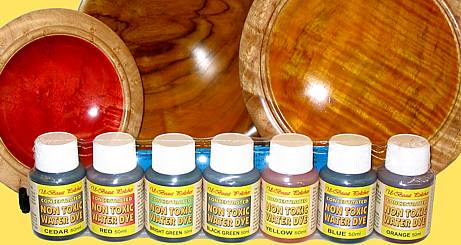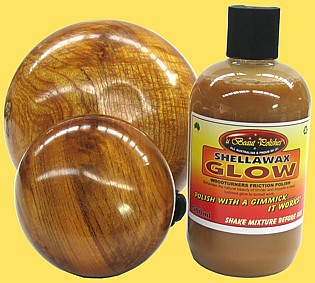Results 1 to 9 of 9
-
22nd March 2014, 06:37 AM #1
 Which is the best finish to really bring out the grain?
Which is the best finish to really bring out the grain?
I've mostly been working with pine for a while, i've gotten used to it. But i can't really seem to make the wood grain "pop". I can see that the grain looks great after i finish sanding it, but even after i apply the stain it doesn't bring out the grain as much as i would want it to.
That's why i wonder what oils/stains could i use to really make it stand out?
Thanks.
-
22nd March 2014, 09:56 AM #2
 ... and this too shall pass away ...
... and this too shall pass away ...











- Join Date
- May 2012
- Location
- Brisbane (Chermside)
- Age
- 71
- Posts
- 0

The grain won't "pop" if it is not there in the first place. The problem with pine is that most of it does not have enough contrast in the grain.
The problem with stains is that they tend to reduce the contrast ... everything gets darker.
Some time ago as I was being dragged through a series of antique stores by LOML it became apparent that some pieces jumped out at me from across a very large room. Others, often with expensive timbers, did not. After a while I figured it out, at least for my personal tastes. The pieces that "jumped out" had contrasting colours in the grain. Walnut and especially burl walnut were good examples. I have an entertainment cabinet in this timber and it is very pretty.
So, I started looking around for timber that had the kind of contrast in the grain such that it really popped. There are quite a few of them, but most are as dear as poison. Then I tried some camphor laurel. Some of it had beautiful grain ... the light/dark contrast jumps out at the viewer from across the room. I have made a few pieces with camphor laurel, and am happy with all of them. More importantly, LOML loves them.
Some timbers are beautiful when viewed close up, but when that beauty fades as one moves further away, I start to lose interest. I have some beautiful dillenia, which looks a lot like silky oak, but is reddish rather than golden. From a reasonably close distance such timbers are gorgeous, but stand three to five metres away and their beauty begins to fade. Right now I am always on the lookout for timber that has the kind of contrast in the grain so the piece jumps at you as you enter a room. A nice piece of camphor laurel can do that at a very reasonable cost.
Cheerio!
John
EDIT
Oops ... just realised which Texas you are from. Nevertheless, camphor laurel is around in the USA. It was introduced to the United States around 1875 and is common in portions of Alabama, California, Florida, Georgia, Hawaii, Louisiana, Mississippi, North Carolina, Texas, and South Carolina. It has been declared an invasive species in Florida (and is a declared noxious weed in parts of Australia for the same reasons). Here are a couple of Pics from a current project in camphor laurel. This is bare timber. The lacquer will really make the grain "pop".
IMAG0566[1].jpgJudy's Legs.jpg
-
22nd March 2014, 03:25 PM #3

Those look amazing!
I see what you mean about the grain. Guess i'm gonna have to find new stuff to work with. I have never heard of camphor laurel.
-
22nd March 2014, 08:27 PM #4
 ... and this too shall pass away ...
... and this too shall pass away ...











- Join Date
- May 2012
- Location
- Brisbane (Chermside)
- Age
- 71
- Posts
- 0

Timber selection is important. If you do a search for turning blanks you will surely find people close enough to you who sell all kinds of pretty timber. I did a search and found USA suppliers who had camphor in stock. Your timber does not need to be camphor. I use it because it is great to work with, finishes well, can be very pretty, and is not expensive here.
Right now I have about 30 camphor turning blanks ... off cuts from the slab I bought. I'll sell them one day, but I'll bet there are woodworkers in Texas who also have a supply of turning blanks in their shop.
Have fun!
John
-
22nd March 2014, 10:21 PM #5

As far as the finish, what's the most common one to use?
I got two huge pieces of tree trunk today (not pine), i don't know what kind it is. I'll take pictures later when the sun is out and see if someone can identify them. I'll be having fun taking all the bark off them, and then cutting them into blanks.
-
23rd March 2014, 12:20 AM #6
 i can't really seem to make the wood grain "pop". I can see that the grain looks great after i finish sanding it, but even after i apply the stain it doesn't bring out the grain as much as i would want it to. That's why i wonder what oils/stains could i use to really make it stand out?
i can't really seem to make the wood grain "pop". I can see that the grain looks great after i finish sanding it, but even after i apply the stain it doesn't bring out the grain as much as i would want it to. That's why i wonder what oils/stains could i use to really make it stand out?
Sorry about the blatant advert that follows below, but I'm just answering the above question.
_______________________________________
G'day Mr Lara
I'm presuming you are in Texas USA and not Texas Queensland here in Aus. Anyway firstly you will be really hard pressed to ever make timber pop using a stain as stain is basically a paint that sits on the top of the timber and blankets the inner beauty of the wood. However, if you use a dye, preferably water based you will then be dying the timberwhich will bring out the inner beauty, or the heart and sole of the timber. this will help it to pop on the right timber, with the right finish and in the right light.
You do not need to stain to pop timber. Look for any timber with figured grain like fiddle-back, flame, quilting, etc. Especially if it is for turning. These are the types of timber that will pop when polished. Contrasting grain such as the timber pictured above don't really pop so much as contrast.
In the below pic the timber on the right with the (fiddleback eucalyptus) is what you would call popped.
The timber in the centre (camphor laurel) is very mostly contrasted.
The timber on the left (Canadian Birdseye Maple) is also popped but it isn't apparent in this pic.

The above bowls were dyed with U-Beaut Water Dyes then finished with Shellawax
The two pieces pictured below (Osage Orange) are well and truly popped, so much so that in the right light
they almost put your eye out with the bright opalescent lights that flash out from within the timber.

To make almost any turned timber pop have a go at using Shellawax in conjunction with EEE Ultra Shine. Even plain old pine will pop and come to life with lights that you will never see with any another finish.
If you want the surface of flat timber to pop, try using White Shellac (dewaxed) or Hard Shellac and a final buffing with EEE-Ultra Shine
NB
- Shellawax, Shellawax Cream and EEE are available in USA through Penn State Industries PA
- Hard Shellac is available in USA through Luthiers Mercantile Inc CA
Hope this is of some help.
Cheers - Neil
-
23rd March 2014, 12:28 PM #7
-
26th March 2014, 08:05 PM #8
 GOLD MEMBER
GOLD MEMBER











- Join Date
- Nov 2012
- Location
- Brisbane
- Posts
- 596
 Is the tree freshly felled or some time ago?
Is the tree freshly felled or some time ago?
Sorry, there are thousands of species to choose from so you probably need to talk to a local in Texas or else show bark, leaves, flowers and fruit to a local botanist for an ID.
Wood shrinks as it dries and can crack badly. So cut logs are usually sealed at the end grain to slow down drying and cracking. Sealers vary from ordinary white acrylic paint to specialized high-wax content wood sealers.
If you are turning the timber to make objects then many wood turners do turn the wood "wet" but shrinkage can be/usually is uneven so you do not end up with a perfectly round object and it can crack.
If you want to make boards for furniture then you must seal the end grain and dry the timber to useable moisture content before you slice it up.. You can buy moisture metes and charts for acceptable moisture levels for your area.
-
26th March 2014, 08:16 PM #9
 GOLD MEMBER
GOLD MEMBER











- Join Date
- Nov 2012
- Location
- Brisbane
- Posts
- 596
 Shellac is the King in finishes
Shellac is the King in finishes
My opinion - for interior use and objects:
If you look at antique objects & furniture and see how the depth of the timber's colour and figure stand out you will see how well a shellac based finish works. In my opinion shellac and its similar products (see Ubeaut's comments/products) work the best for furniture. I have no expertise on turning so I will leave that to others.
As Neil said, oil stains just muddy up the figure so are not good. Either the water based stains or, I have found some spirit stains, can add colour but still allow the depth and beauty of the timber to show.
Many of the polyurethane and lacquer finishes can look good but are unproven with time. Once they begin to deteriorate they have to be stripped off and that is a hard job. A shellac finish is easy to restore.
Similar Threads
-
Grain filling with oil finish
By Ben from Vic. in forum FINISHINGReplies: 11Last Post: 10th April 2009, 03:32 AM -
End grain finish
By wattlewemake in forum FINISHINGReplies: 5Last Post: 26th November 2007, 04:00 PM -
Black Japan - bring out grain, or just blacken?
By FlyingDuck in forum FINISHINGReplies: 5Last Post: 12th July 2006, 10:37 PM -
end grain finish
By hoopy in forum FINISHINGReplies: 1Last Post: 17th May 2006, 02:19 AM





 Reply With Quote
Reply With Quote




Bookmarks